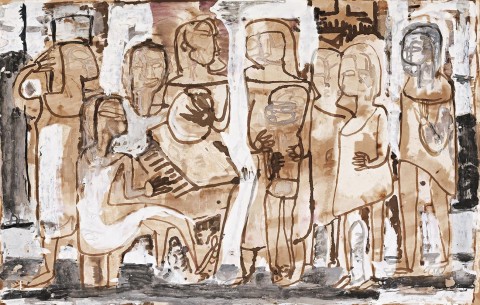SELF-PORTRAIT, 1951
IAN FAIRWEATHER
gouache on paper on board
53.0 x 83.5 cm
inscribed with title lower right: ‘Self Portrait’
label attached verso: National Gallery of Australia, Canberra
Macquarie Galleries, Sydney
Alan and Nola Geddes, Sydney
Estate of Nola Geddes, Sydney
Easter Exhibition, Macquarie Galleries, Sydney, 2 – 14 April 1969, cat. 10
Bail, M., Ian Fairweather, Bay Books, Sydney and London, 1981, cat. 91, fig. 48, pp. 107 (illus.), 238
Eagle, M., ‘The Painter and the Raft’ in Bail, M., et. al., Fairweather, Art & Australia Books in association with Queensland Art Gallery, Brisbane, 1994, pp. 27 (illus.), 29
Bail, M., Fairweather, Murdoch Books, Sydney and London, 2009, p. 94
Ian Fairweather has been described as ‘the least parochial of Australian painters, an artist of exceptional force and originality’1 and he is undeniably one of the most singular artists to have worked in Australia during the twentieth century. Although he is claimed as an Australian and spent many years of his life here – famously living in a shack on Bribie Island, where he produced some of his most highly regarded work between 1953 and his death in 1974 – Fairweather was born in Scotland and undertook his formal art education at London’s Slade School of Fine Art. With a restless spirit, he travelled extensively – from London, to Canada, China, Bali, Australia, the Philippines, India and beyond – ‘always the outsider, the nostalgic nomad with a dreamlike memory of distant places and experience’.2
Following the purchase of Seated Figure, 1948 by the Art Gallery of New South Wales and his first solo exhibition at the Macquarie Galleries, Sydney, both in 1949, Fairweather visited Townsville in far north Queensland for several months before hitch-hiking to Darwin, arriving there in mid-April 1950. Domestic comforts were never a priority and after initially taking up residence in a concrete mixer and an abandoned railway truck, he later moved into the Karu, a boat wreck on Dinah Beach at Frances Bay. Known among the locals as ‘Rear Admiral’, Fairweather lived there for the next two years and, although there was room for his paintings to be hung as he worked, water would pour down the walls when it rained forcing him to remove them ‘and sit on them like a hen’.3
Painted in Darwin, Self-Portrait, 1951 is one of a small group of related works which ‘read like direct expressions of the artist’s subconscious’4 at the time. Fairweather suffered from feelings of self-pity during these years as well as paranoia about his paintings which were often damaged upon arrival at his Sydney gallery – the result of his working environment and haphazard approach to the use of materials and technique rather than anything suspicious. The now infamous culmination of his precarious emotional and psychological state in Darwin was the ill-fated raft journey on which he aimed to sail to Timor, but instead, saw him washed up hallucinating and exhausted on the beach at Roti, an island between the Savu and Timor Seas.
Painted on a large sheet of paper, this work employs Fairweather’s fluid and calligraphic line to describe a group of standing figures gathered around another who is seated and playing a piano. This subject appears again in the later work, Palm Sunday, 1951 (Queensland Art Gallery, Brisbane) but in its immediate, edgy treatment, the spaces between the figures filled in with expressively applied fields of black and white gouache, Self-Portrait has more in common with the plainly titled Hell, 1950 (Ian Potter Museum of Art, University of Melbourne), the claustrophobia of which clearly spells out the emotional temperament of its maker. Rather than depicting himself, Fairweather has produced what Murray Bail interprets as an inverse self-portrait in this work,5 the convivial crowd gathered together in the joyous collective act of making music the opposite of his isolated and increasingly desolate state.
1. Bail, M., Ian Fairweather, Bay Books, Sydney, 1981, p. 220
2. Bail, M., ‘The Nostalgic Nomad’, Hemisphere, Canberra, vol. 27, no. 1, 1982, p. 54
3. See Bail, 1981, op. cit., pp. 94 & 100
4. Eagle, M., ‘The Painter and the Raft’, Bail, M., et. al., Fairweather, Art & Australia Books in association with Queensland Art Gallery, Brisbane, 1994, p. 29
5. Conversation with Chris Deutscher, 24 July 2018
KIRSTY GRANT
